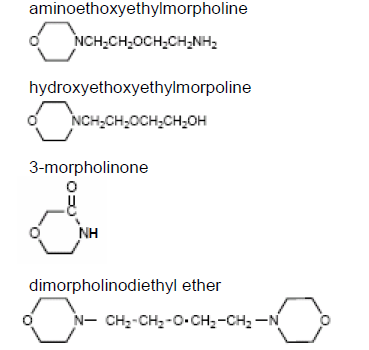Enhanced TDS
Identification & Functionality
- Chemical Family
- Chemical Name
- Supplied By
- Base Chemicals Functions
- CAS No.
- 68909-77-3
- EC No.
- 272-712-1
- Technologies
- Product Families
- Chemical Constituents

Applications & Uses
- Markets
- Applications
- Segments
- Base Chemicals End Uses
Properties
- Physical Form
- Appearance
- Clear, dark amber liquid
- Odor
- Ammonia like
- Miscible in
- Water
Safety & Health
- Toxicity and Safety Information
- The acute oral LD50 of Amine C-8 is approximately 8.75 g/kg and the product is considered, therefore, to be practically nontoxic by swallowing in single doses.
- The undiluted product appears to penetrate skin readily, since the LD50, by single 24-hour skin contact to rabbits is about 3.85 g/kg.
- Nevertheless, the latter figure indicates only a moderate to slight degree of hazard insofar as actual absorption through the skin is concerned.
- Skin irritation to rabbits is slight at the lowest dosage and increases in severity with increasingly higher dosages.
- Undiluted Amine C-8 is very irritating to eyes.
- As with other caustic materials, dilution with water would be expected to reduce this hazard.
- In case of eye contact, the eye should be irrigated continuously with water for at least 15 minutes.
- A physician should see all cases in which undiluted Amine C-8 has splashed into the eye.
- All spills of Amine C-8 on the skin should be washed off promptly with soap and water.
- If clothing has become saturated, it should be removed at once, and affected skin areas washed thoroughly with soap and water.
- Such measures will aid in preventing immediate irritant effects as well as the development of skin sensitivity that may occur in susceptible persons from prolonged contact or repeated exposure.
- Vapor concentrations of Amine C-8 that are likely to develop under ordinary working conditions would constitute little immediate hazard to health.
- Acutely dangerous exposures might be expected to occur only after massive spills in closely confined areas. Although no threshold limit for Amine C-8 vapor has been established, the breathing of high concentrations should be avoided.
- A chemical cartridge respirator or gas mask, offering protection against organic vapor, should be worn when entering vessels for purposes of cleaning or maintenance unless thoroughly flushed with water beforehand.
- It has been observed that certain individuals exposed to vapor of aliphatic amines may complain of hazy vision as from a film over the eye.
- This symptom may develop at vapor concentrations that cause no obvious discomfort.
- It is said to result from a mild degree of corneal edema, and disappears without residual injury several hours after discontinuance of exposure.
- This is reported to occur after exposure to a number of amines and must be regarded as a sign of overexposure.
- Amine C-8 should be handled only in well-ventilated areas.
- Wherever practical, process equipment should be provided with exhaust ventilation to prevent buildup of vapor concentrations in the workroom atmosphere.
- Personal protective equipment that should be used by persons handling concentrated solutions of Amine C-8 is:
- Rubber gloves
- Rubber footwear
- Chemical goggles
- Protective overalls
- Maintenance personnel at work on equipment that has contained Amine C-8 should wear the above listed protective equipment.
Packaging & Availability
Storage & Handling
- Storage and Handling Information
- Carbon steel is a satisfactory material for storing and handling Amine C-8.
- Copper, zinc, lead, or alloys containing any of these materials should not be used since they will be attacked by the product.
- The freezing point will vary over a wide range.
- Since it can freeze as high as 50°C (122°F), it will be necessary to provide heat to the storage tank.
- Generally, this can be done by utilizing either internal or external heating coils of a suitable area to heat the tank contents.
- If these coils are internal, they should be built into the tank about six inches above the floor and operated on low-pressure steam.
- The coils should be constructed in such a manner as to allow the condensate to drain.
- Mild steel is acceptable for transfer lines. Since the product will leach conventional pipe dopes from threaded connections, the lines should be welded or flanged.
- Satisfactory gasketing materials are Garlock 7021, U.S. Rubber 899, John Crane 333, Johns- Manville 70, or equivalent.
- Carbon steel centrifugal pumps are satisfactory.
- Either pump packing or a mechanical seal may be used.
- Braided Teflon or asbestos are satisfactory packing materials.
- Seals may be John Crane Type 9, Durametallic Type RO-TT, or equivalent with either stellite and carbon or tungsten faces and Teflon V-rings.
